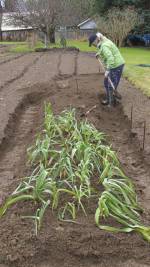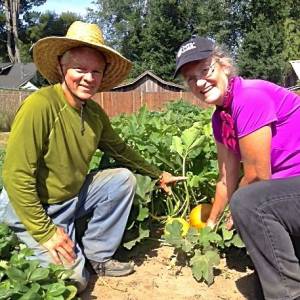Table of Contents
A bit about our gardens
Beginning in Carnation, 2012
In 2012 Maura and David gardened at the Nootka Rose Community Garden at the Carnation Tree Farm. They wanted to find a place to garden closer to their home near Snoqualmie. Janna Treisman, who they knew through Transition Snoqualmie Valley, mentioned that she knew someone who had property in Fall City that we might cultivate. They met with Janet Ewing and talked about their intention and made a deal to contribute a part of what they grew to the Fall City Food Pantry.
Fall City garden, 2013
 In January 2013 they transplanted their leeks from the Carnation garden to over-winter in Fall City, then in spring they tilled and built the soil, planting English peas first, then several types of beans. Their big project was to grow tomatoes to can so they transplanted almost 40 plants. That turned out to be a very poor year for tomatoes and late season blight took a huge toll and they lost about 85% of the potential yield. That first year in Fall City they also grew pumpkins, summer and winter squash, potatoes, tomatillos, spinach, lettuce, carrots, chard, 8 varieties of beans, corn, cucumbers, leeks, basil, beets, radishes, strawberries, turnips, rhubarb, and garlic. Along with this they had planted a patch of about 200 flint corn further down river on Janna’s farm; beautiful ruby, gold and orange corn grown for milling into cornmeal.
In January 2013 they transplanted their leeks from the Carnation garden to over-winter in Fall City, then in spring they tilled and built the soil, planting English peas first, then several types of beans. Their big project was to grow tomatoes to can so they transplanted almost 40 plants. That turned out to be a very poor year for tomatoes and late season blight took a huge toll and they lost about 85% of the potential yield. That first year in Fall City they also grew pumpkins, summer and winter squash, potatoes, tomatillos, spinach, lettuce, carrots, chard, 8 varieties of beans, corn, cucumbers, leeks, basil, beets, radishes, strawberries, turnips, rhubarb, and garlic. Along with this they had planted a patch of about 200 flint corn further down river on Janna’s farm; beautiful ruby, gold and orange corn grown for milling into cornmeal.
Fall City garden, 2014
They got a slow start this year with a cover crop of rye that was so “successful” that it took weeks to terminate it and figure out what to do with all the straw. They're still working on this!
 Two of their successful crops this year are Cherokee Trail of Tears beans and New England Pie Pumpkins. The Trail of Tears beans are named for the forced relocation of the Cherokee Indians from the Great Smoky Mountains to Oklahoma over the winter of 1838 - 1839, during which time many thousands of people died. This nutritious black bean helped sustain the Cherokees through the arduous journey.
Two of their successful crops this year are Cherokee Trail of Tears beans and New England Pie Pumpkins. The Trail of Tears beans are named for the forced relocation of the Cherokee Indians from the Great Smoky Mountains to Oklahoma over the winter of 1838 - 1839, during which time many thousands of people died. This nutritious black bean helped sustain the Cherokees through the arduous journey.
A pie pumpkin provides about enough flesh for one pie and cooks down to a sweet, creamy, and thick filling. They look forward to sharing these pumpkins at the Food Pantry.
They cultivate about two-thirds of the area each year, leaving the remainder fallow or in cover crops, intending to gradually increase the soil fertility.
Sustainable gardening
They are learning organic farming and use hand tools almost exclusively. They build the soil with green manure, compost and techniques that improve the structure and fertility of the soil with a minimum of tilling. Every day is an experiment in imagining how to build a sustainable gardening operation.
They also garden at their home near Snoqualmie in five raised beds, but the altitude, climate and tree shading greatly limit the growing season and choice of varieties, so the Fall City garden is their primary growing area, though this summer has been particularly warm and sunny so even their home garden is thriving.
Background
David grew up with a family garden in Texas and with a half dozen aunts and uncles who dry-land farmed there, so there is some agriculture in his DNA. However, gardening in the Pacific Northwest is quite different from gardening in central Texas, so it was like starting off with a clean slate. Maura, who was raised in a small mid-western city, had a plot at the first Seattle Pea Patch back in the early 70’s where she grew vegetables just to see what they looked like!
Philosophy
They believe that local production of food, both individual and commercial, are becoming more and more important and are learning the ins and outs of growing healthy, organic vegetables. They believe that sharing in general is a satisfying and mutually beneficial habit, so they routinely contribute some of their production to the Fall City Community Food Pantry, as well as to Janet, co-workers, friends and family.
